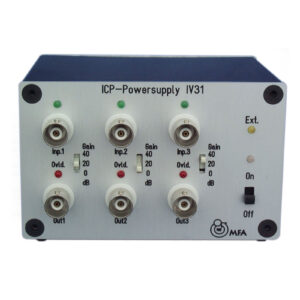Areas of application
- Constant current supply for IEPE transducers or IEPE microphones
Functions
- Any number of input and output channels available
- Optional gain: 0 dB, +20 dB, +40 dB switchable
- Optional filter, e.g. A-filter, high-pass filter, low-pass filter
- Overload display and sensor display per channel
- BNC input and output connectors, others possible
- 5 V DC mini-USB, 12 V DC mains operation and / or battery operation
The devices in the IVxx series supply the constant current required for IEPE sensors. The power supply units can be freely configured so that any number of channels, amplification, filters, housing shape etc. can be freely selected by the customer.
The devices in the IVxx series can be operated in battery mode completely independently of a power supply or in mains mode with 12 V DC, e.g. by connecting them to the vehicle electrical system. The mains adapter supplied enables the batteries to be charged from the normal mains supply.
Technical background
IEPE (Integrated Electronics Piezo-Electric) power supply refers to a method of supplying power to sensors, particularly piezoelectric sensors, used in various measurement and instrumentation applications. ICP®, CCLD, Isotron®, Deltatron®, Piezotron® are manufacturer designations for sensors based on this principle.
The IEPE power supply unit typically supplies the sensor with a 4mA constant current. This constant current source is essential for maintaining the stability of the sensor and ensuring reliable measurements.
IEPE sensors normally have a low output impedance, which enables efficient signal transmission over long cables without significant signal degradation.
Another advantage of IEPE is that the sensor is powered via a single coaxial cable. This simplifies cabling in complex measurement setups. A disadvantage of this principle is that there is an inherent noise which influences the measurement result (see technical data).










